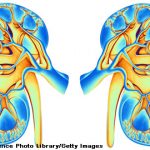Insights into osteoporosis treatments as societies around the world age.


Insights into osteoporosis treatments as societies around the world age.

In late December, the FDA approved subcutaneous abaloparatide for the treatment of men with osteoporosis at a high risk of fracture. This approval is based on a placebo-controlled study that showed abaloparatide led to significant increases in bone mineral density of the lumbar spine, total hip and femoral neck. Abaloparatide was approved in April 2017 for the treatment of postmenopausal women with osteoporosis at high risk for fracture.

In a small study of men with low bone mineral density (BDM) living with HIV and taking anti-retroviral therapy, both zoledronate or denosumab were well tolerated and effective for bone mineral density of the lumbar spine and femoral neck.
Will Boggs, MD |
NEW YORK (Reuters Health)—Using bisphosphonates for several years is associated with increasing brittleness and decreasing toughness of bone, according to a new review. “Long-term treatment with bisphosphonates can have negative side effects in some people because of their effects on bone toughness [toughness = the energy that bone tissue can absorb before cracking],” David B….

In a clinical trial, researchers compared the efficacy of abaloparatide with alendronate in reducing the risk of fracture among postmenopausal women with osteoporosis. The findings suggest initial treatment with abaloparatide may result in greater vertebral fracture reduction than alendronate…
Megan Brooks |
NEW YORK (Reuters Health)—Denosumab injection delays of more than four months are associated with an increased risk of fracture compared with on-time injections, especially at the spine, new research indicates. “This study suggests the importance of timely denosumab administration when used for long-term osteoporosis management,” the researchers write in Annals of Internal Medicine.1 “When starting…

Suggestions on how to assess risk and manage bone issues in chronic kidney disease patients are offered…
Marilynn Larkin |
NEW YORK (Reuters Health)—In postmenopausal women and men treated for at least two years with denosumab, a single infusion of zoledronate given after denosumab discontinuation does not completely prevent bone turnover and loss, researchers say. Given the findings, “bone mineral density (BMD) should probably be higher than the current target for discontinuation of bisphosphonate treatment…
Lisa Rapaport |
(Reuters Health)—Patients hospitalized for a hip fracture are less likely to experience a subsequent fracture-related hospitalization if they start anti-osteoporosis medication sooner, a Taiwanese study suggests.1 Researchers examined data on 77,930 patients aged 50 years and older hospitalized for hip fractures, including 9,986 people prescribed anti-osteoporosis medications within one year of the index fracture. Compared…
Anne Harding |
NEW YORK (Reuters Health)—Adding high-dose teriparatide to denosumab therapy leads to substantially greater increases in bone-mineral density (BMD) than combination therapy with low-dose teriparatide, a new phase 4 study shows. “The combination of denosumab and teriparatide, particularly with high-dose teriparatide of 40 ug daily, may be of benefit to patients at very high risk of…